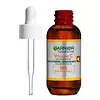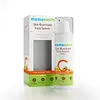What's inside
What's inside
 Key Ingredients
Key Ingredients

 Benefits
Benefits

 Concerns
Concerns

No concerns
 Ingredients Side-by-side
Ingredients Side-by-side

Water
Skin ConditioningAscorbic Acid
AntioxidantPentylene Glycol
Skin ConditioningGlycerin
HumectantSodium Hydroxide
BufferingHydroxyacetophenone
AntioxidantSalicylic Acid
MaskingCaprylyl Glycol
EmollientCaprylyl/Capryl Glucoside
CleansingPolyquaternium-67
Adenosine
Skin ConditioningTrisodium Ethylenediamine Disuccinate
Sodium Hyaluronate
HumectantLinalool
PerfumingLimonene
PerfumingGeraniol
PerfumingParfum
MaskingWater
Skin ConditioningEthoxydiglycol
HumectantMagnesium Ascorbyl Phosphate
AntioxidantSodium Palmitoyl Proline
Skin ConditioningNymphaea Alba Flower Extract
Skin ConditioningTriheptanoin
Skin ConditioningButylene Glycol
HumectantSodium Hydroxide
BufferingSophora Flavescens Root Extract
AntioxidantGlycyrrhiza Inflata Root Extract
Skin ConditioningScutellaria Baicalensis Root Extract
AstringentAcrylates Crosspolymer
AbsorbentDiethylhexyl Carbonate
EmollientGlycerin
HumectantSqualane
EmollientCaprylhydroxamic Acid
Behenyl Alcohol
EmollientPhysalis Angulata Extract
Skin ProtectingCaprylic/Capric Triglyceride
MaskingTetrahydrocurcumin
AntioxidantCetyl Ricinoleate
EmollientCaesalpinia Spinosa Gum
Skin ConditioningSodium Hyaluronate
HumectantDimethylmethoxy Chromanol
AntioxidantSodium Metabisulfite
AntioxidantWater, Ethoxydiglycol, Magnesium Ascorbyl Phosphate, Sodium Palmitoyl Proline, Nymphaea Alba Flower Extract, Triheptanoin, Butylene Glycol, Sodium Hydroxide, Sophora Flavescens Root Extract, Glycyrrhiza Inflata Root Extract, Scutellaria Baicalensis Root Extract, Acrylates Crosspolymer, Diethylhexyl Carbonate, Glycerin, Squalane, Caprylhydroxamic Acid, Behenyl Alcohol, Physalis Angulata Extract, Caprylic/Capric Triglyceride, Tetrahydrocurcumin, Cetyl Ricinoleate, Caesalpinia Spinosa Gum, Sodium Hyaluronate, Dimethylmethoxy Chromanol, Sodium Metabisulfite
 Reviews
Reviews

Alternatives
Ingredients Explained
These ingredients are found in both products.
Ingredients higher up in an ingredient list are typically present in a larger amount.
Glycerin is already naturally found in your skin. It helps moisturize and protect your skin.
A study from 2016 found glycerin to be more effective as a humectant than AHAs and hyaluronic acid.
As a humectant, it helps the skin stay hydrated by pulling moisture to your skin. The low molecular weight of glycerin allows it to pull moisture into the deeper layers of your skin.
Hydrated skin improves your skin barrier; Your skin barrier helps protect against irritants and bacteria.
Glycerin has also been found to have antimicrobial and antiviral properties. Due to these properties, glycerin is often used in wound and burn treatments.
In cosmetics, glycerin is usually derived from plants such as soybean or palm. However, it can also be sourced from animals, such as tallow or animal fat.
This ingredient is organic, colorless, odorless, and non-toxic.
Glycerin is the name for this ingredient in American English. British English uses Glycerol/Glycerine.
Learn more about GlycerinSodium Hyaluronate is hyaluronic acid's salt form. It is commonly derived from the sodium salt of hyaluronic acid.
Like hyaluronic acid, it is great at holding water and acts as a humectant. This makes it a great skin hydrating ingredient.
Sodium Hyaluronate is naturally occurring in our bodies and is mostly found in eye fluid and joints.
These are some other common types of Hyaluronic Acid:
Learn more about Sodium HyaluronateSodium Hydroxide is also known as lye or caustic soda. It is used to adjust the pH of products; many ingredients require a specific pH to be effective.
In small amounts, sodium hydroxide is considered safe to use. However, large amounts may cause chemical burns due to its high alkaline.
Your skin has a natural pH and acid mantle. This acid mantle helps prevent harmful bacteria from breaking through. The acid mantle also helps keep your skin hydrated.
"Alkaline" refers to a high pH level. A low pH level would be considered acidic.
Learn more about Sodium HydroxideWater. It's the most common cosmetic ingredient of all. You'll usually see it at the top of ingredient lists, meaning that it makes up the largest part of the product.
So why is it so popular? Water most often acts as a solvent - this means that it helps dissolve other ingredients into the formulation.
You'll also recognize water as that liquid we all need to stay alive. If you see this, drink a glass of water. Stay hydrated!
Learn more about Water